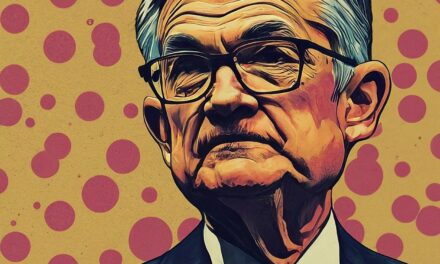This week, America’s most powerful central bankers are all effectively on vacation — taking in the breathtaking scenery in picturesque Jackson Hole, Wyoming, while they discuss the fate of the economy.
Fed Chairman Powell is expected to signal a coming rate cut that could drive markets higher.
But how big will that rate cut be? And what will it mean for an economy that seems to be sputtering out in the midst of Trump’s transformative policies?
Let’s dive into the details and find out.
Click below to roll the video:
Video transcript:
Hi, I’m Andrew Zatlin. This is Moneyball Economics.
As you can tell, I’m feeling pretty good today. Part of that’s because I just returned from West Point. This weekend, I got to see my son accepted to West Point. It’s pretty exciting and in fact, in a tribute to him and in solidarity with him, I’m keeping my buzz cut going. I hope you like it.
But the other reason I’m bullish this week has to do with the coming meeting by the Fed in Jackson Hole, Wyoming.
All the members of the Fed are going off to Jackson Hole. And they’re bringing with them all the cronies and all their buddies from Wall Street, and this meeting matters. This is the meeting when the Fed is going to tip their hand in terms of where they think the economy’s going and how they’re going to respond with interest rate cuts.
So we know that September is the next formal meeting of the Fed when they actually vote, but this is the week when they tip their hand. This is the week that matters. In fact, in this week, historically, the stock market likes to go up on average about almost 1% for the week, and that’s why, for example, on Monday this week, you might’ve noticed, or maybe it didn’t, the volume was very low on Monday. The volume of trading was the lowest it has been since May.
Why?
Well, everyone’s keeping their powder dry. They want to take full advantage going out with what the Fed’s thinking. And right now the guesswork is, it’s not so much is the rate cut going to happen, but how deep I am in the place where I think a rate cut’s inevitable. And I think it’s inevitable for two reasons.
One of them is it’s what the data’s telling us. But the other is it’s what the makeup of the Federal Reserve Board voters is…
What I mean is there are 19 people on the FOMC. There are 19 players out there, but only 12 of them get to vote. If you were to stack rank them from most likely, the dovish, to the least likely to make a rate cut. the most hawkish, what’s interesting is the most hawkish folks are also the ones who don’t get to vote this year. So it’s the doves who are in control and doves like to do interest rate cuts.
The question then is 25 basis points or 50 basis points to know that we’ve got to look at the recent economic data.
We can start with a couple of weeks ago payrolls, we found out for three months running payrolls have been terrible and there’s no particular indication that they’re going to get that much stronger, and that’s something that the Fed has to watch is employment.
Last week we got a little bit more insight into employment with jobless claims, which again came out pretty good. They’re not falling down. They’re in that pretty good zone. So it offsets a little bit of the sting from payrolls, but there are some questions about both data points.
Suffice it to say that, well, it’s not expansionary per se that the labor market isn’t looking soggy. If you look at jobless claims, it’s looking super awful. If you’re looking at payrolls, split the difference, maybe it’s time to do a rate cut.
The other thing the Fed’s looking at, well, it’s inflation. The inflation story is definitely not dovish. It’s hawkish inflation. Whether you’re talking CPI, the consumer or PPI, the wholesalers, the factories, well looking a little bit hot and probably going to get hotter. What do you do? You’re trapped in a zone where you can’t bring down interest rates. Do you just accept it and move on? Possibly.
There’s another place that the Fed’s looking and that is how are consumers doing? Are consumers spending and is that pace of spending accelerating, decelerating? Where are we? And for that, we got a snapshot last week with retail.
Now I was wrong on retail. I was much more bullish than what came out. You never know though. They might revise it up next month, but it came out with a fairly robust number and it was very much in line with consensus, but it had a little bit of a one-time boost.
I overestimated that one-time boost. It was the Amazon Prime Day effect. My number was a lot higher, and as a result, I came out with a stronger number. Suffice it to say you remove that Amazon Day event, and what we come up with is retail spending is pretty much flowing in line with wages and salaries.
In other words, the economy’s only as good as wage growth and if inflation’s chewing up the wage growth, we have stagflation. We’ve got a stagnant economy with inflation, not the place where the Fed wants to be.
There’s so much pressure right now that they may look past some of this data. It is after all backwards looking and they may sort of extrapolate forward and say, jobs market, labor markets probably not going to get much better. Jobless claims might even start to trickle up a little bit.
Actually, let’s put an asterisk on there. We know jobless claims are going to go up starting in October because that’s when all the government employees are being kicked to the curb. So there’s going to be about 200,000 to 250,000 people suddenly out of work. Yeah, yeah. They might retire, they might have jobs or whatever, doesn’t matter. They’re going to be saving. They’re going to spend whatever money they have. They’re not going to do, I’m sorry. They’re going to be trying to hold onto whatever money they have. They don’t have jobs.
So the Fed’s probably looking out there going, I see a lot of turbulence up ahead. I see a lot of headwinds. Let’s counter the headwinds sooner rather than later. With a little rate cut, is it going to be 25 or 50 basis points? That really is a coin flip. I think with inflation out there and with the spending by consumers still relatively strong, I’d like to see 50 basis points.
We’ll probably only see 25, but you never know. End result. We’re going to get something. The market’s going to love it. Markets are going to move up on Friday. Position yourself accordingly. What it says about the economy going forward is it’s positive, mostly.
The economy’s not collapsing. The economy’s not raging. It’s kind of a Goldilocks situation and a little bit of a stepping on the gas is good at this time. That’s what everyone wants. The Fed will probably deliver, and that’s a good thing for you and me as consumers and as investors.
We’re in it to win it, folks.
Zatlin out.

Andrew Zatlin
Editor, Moneyball Economics





